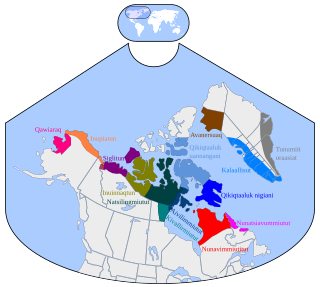Inuttitut,[1] Inuttut,[2] or Nunatsiavummiutitut[3] is a dialect of Inuktitut. It is spoken across northern Labrador by the Inuit, whose traditional lands are known as Nunatsiavut.
| Inuttitut | |
|---|---|
| Nunatsiavummiutitut | |
| Labrador Inuktitut | |
| Native to | Canada |
Early forms | |
| Language codes | |
| ISO 639-3 | – |
| Glottolog | nuna1235 |
 Inuit dialects. Nunatsiavummiutitut is the pink ( ) in the east. | |
 Nunatsiavummiutitut is classified as Definitely Endangered by the UNESCO Atlas of the World's Languages in Danger | |
The language has a distinct writing system, created in Greenland in the 1760s by German missionaries from the Moravian Church.[citation needed] This separate writing tradition, the remoteness of Nunatsiavut from other Inuit communities, and its unique history of cultural contacts have made it into a distinct dialect with a separate literary tradition.
It shares features, including Schneider's Law, the reduction of alternate sequences of consonant clusters by simplification, with some Inuit dialects spoken in Quebec. It is differentiated by the tendency to neutralize velars and uvulars, i.e. /ɡ/ ~ /r/, and /k/ ~ /q/ in word final and pre-consonantal positions, as well as by the assimilation of consonants in clusters, compared to other dialects. Morphological systems (~juk/~vuk) and syntactic patterns (e.g. the ergative) have similarly diverged. Nor are the Labrador dialects uniform: there are separate variants traceable to a number of regions, e.g. Rigolet, Nain, Hebron, etc.
Although Nunatsiavut claims over 4,000 inhabitants of Inuit descent, only 550 reported any Inuit language (Inuktut) to be their mother tongue in the 2001 census, mostly in the town of Nain. Inuttitut is seriously endangered.
Alphabet
editNunatsiavut uses a Latin alphabet devised by German-speaking Moravian missionaries, which includes the letter ĸ (kra, often also written with an uppercase K). In 1980, the Labrador Inuit Standardized Writing System was developed during a meeting with elders and educators to provide consistency and clarity.[4] The previous orthography used ⟨o⟩ to represent /u/ before uvulars; however, the Labrador Inuttitut no longer has a distinct /q/ at the end of syllables. In the new orthography, ⟨o⟩ represents /uu/.[5]
| Capital letters | ||||||||||||||||||||
|---|---|---|---|---|---|---|---|---|---|---|---|---|---|---|---|---|---|---|---|---|
| Â | A | E | F | G | H | I | J | K | Kʼ | L | M | N | O | P | R | S | T | U | V | W |
| Lowercase letters | ||||||||||||||||||||
| â | a | e | f | g | h | i | j | k | ĸ | l | m | n | o | p | r | s | t | u | v | w |
The main difference with the Latin orthography used for other Inuktitut dialects are the following letters:[5]
- /aː/ â = aa
- /iː/ e = ii
- /uː/ o = uu
- /χ/ ĸ = q
- /ŋŋ/ ng, n̲g̲ or ngng = nng
Dialects
editAt one time, there existed two dialects of the Inuttut language. The northern dialect (spoken mainly in Nain) and the southern dialect (spoken only by a few elders in Rigolet).[6] They differ only in phonology.
Vocabulary comparison
editThe comparison of some animal names in the two dialects of Inuktitut:
| Inuktitut[7] | Inuttitut[8] | meaning |
|---|---|---|
| siksik ᓯᒃᓯᒃ | sitsik | ground squirrel |
| qugjuk ᖃᒡᔪᒃ | ĸutjuk | tundra swan |
| aarluk ᐋᕐᓗᒃ | âlluk | killer whale |
| amaruq ᐊᒪᕈᖅ | amaguk | grey wolf |
| isunngaq ᐃᓱᙵᖅ | isungak | pomarine jaeger |
| kanguq ᑲᖑᖅ | kangak | snow goose |
| tuktu ᑐᒃᑐ | tuttuk | caribou |
| tiriganniaq ᑎᕆᒐᓐᓂᐊᖅ | tigiganniak | arctic fox |
| umingmak ᐅᒥᖕᒪᒃ | umimmak | muskox |
German loanwords
editThe German loanwords[8] used in Inuttitut date from the period of the German missionaries of Moravian Church (1760s).
- ailvat (< Ger. elf) 'eleven'
- ainsik (< Ger. eins) 'one o'clock'
- fiarâ (< Ger. vier) 'four o'clock'
- Fraitâg ( < Ger. Freitag) 'Friday'
- kâttopalak (< Ger. Kartoffel) 'potato'
- Metvog (< Ger. Mittwoch) 'Wednesday'
- Montâg (< Ger. Montag) 'Monday'
- naina (< Ger. neun) 'nine'
- sâksit (< Ger. sechs) 'six'
- senat (< Ger. zehn) 'ten'
- sepat (< Ger. sieben) 'seven'
- silipa (< Ger. Silber) 'coin'
- situnati (< Ger. Stunde) 'hour'
- Sontâg (< Ger. Sonntag) 'Sunday'
- Sunâpint (< Ger. Sonnabend) 'Saturday'
- suvai (< Ger. zwei) 'two'
- suvailva (< Ger. zwölf) 'twelve'
- tarai (< Ger. drei) 'three'
- taraitijik (< Ger. dreißig) '30 odd 30 rifle and ammunition'
- Tenistâg (< Ger. Dienstag) 'Tuesday'
- Tonistâg (< Ger. Donnerstag) 'Thursday'
- viaga (< Ger. vier) 'four'
- vogik (< Ger. Woche) 'week'
References
edit- ^ "Labrador Inuit delegation disappointed Premier not available to discuss concerns with north coast ferry". Nunatsiavut Government. 2019-09-26. Retrieved 2023-10-15.
- ^ "Inuttut Dictionary : Labrador Virtual Museum". www.labradorvirtualmuseum.ca. Retrieved 2023-10-15.
- ^ "What is Inuktut?". tusaalanga.ca. Retrieved 2024-11-04.
- ^ "Inuttitut (Labrador)". Canadian Bible Society. Archived from the original on 2017-02-15. Retrieved 2016-08-24.
- ^ a b Andersen, Catharyn; Johns, Alana (2005). "Labrador Inuttitut: Speaking into the future". Études/Inuit/Studies. Vol. 29, no. 1–2. pp. 187–205.
- ^ "The Inuktitut/Inuttut Language".
- ^ Inuktitut Living Dictionary
- ^ a b "English-Inuttut Dictionary".
Further reading
edit- Smith, L. R., and Sam Metcalfe. Labrador Inuttut – English Glossary. [St. John's]: Memorial University of Newfoundland, 1970.
- Smith, Lawrence .R. (1975) "Labrador Inuttut surface phonology". International journal of American linguistics 41 (2), 97-105.
Dorais, Louis-Jacques (1981) Reviews Etudes/Inuit Studies 5 (1) 149-152